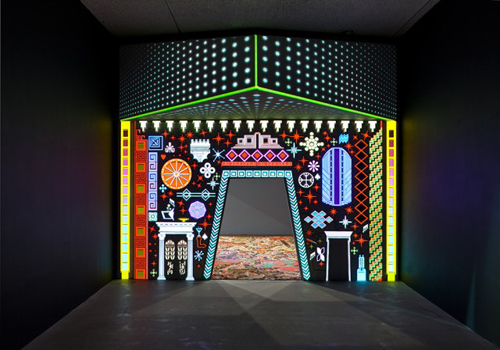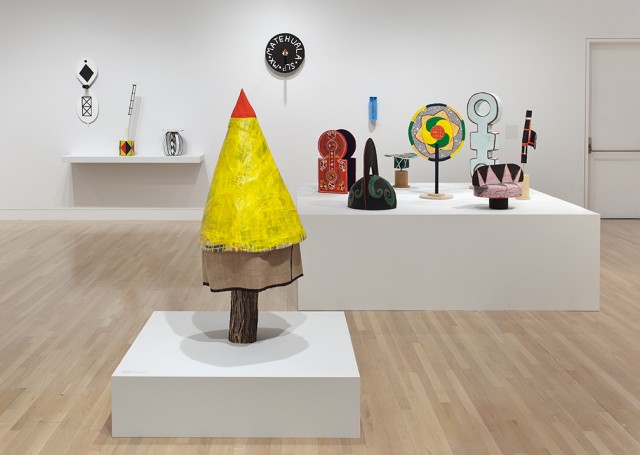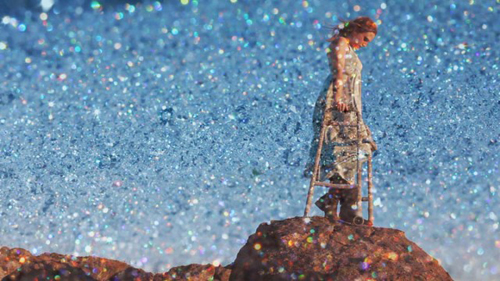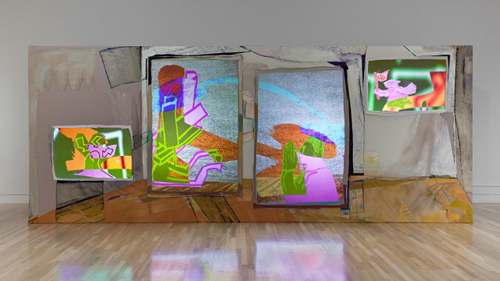

Cayetano Ferrer. Quarter-Scale Grand Entrance, 2012. Made in L.A.Installation view at Los Angeles Municipal Art Gallery, Barnsdall Park, Los Angeles, June 2, 2012-September 2, 2012. Photo by Brian Forrest.
LA has a strange relationship with its arts institutions. Artists and critics are quick to bash the few museums it has; witness the razing local critics and artists have given MOCA over the last several months. Never mind that wonderful exhibitions like Amanda Ross-Ho: Teeny Tiny Woman run for a three-month period, it's the one night party bash that advertised Drew Barrymore as featured artist, that had the community sputtering cries that the museum's turn to celebrity was going to be it's downfall. (To be fair, I have just completely over simplified the complex situation at MOCA into two sentences.) The constant slamming of the only Los Angeles contemporary museum can't possibly help it's already dire straits.
So it was not really surprising that the day after the Hammer's opening of Made in LA, it's first official biennial with a cash prize of $100,000 to go to the audience's pick, the exhibition would come under heavy criticism. Almost everyone I talked to told me they did not like the show, that they didn't believe that it is representational of the LA art scene and that it was a disappointment. I haven't as of yet seen one enthusiastic endorsement for the exhibition online, so let me be the first.
First of all, with 60 artists in the exhibition stretched across three exhibition spaces, how can you expect to like everything? To like even most of the artwork in the show seems impossible. I choose to go by what Christopher Knight said in his LA Times review: "My rule of thumb for a successful biennial is wanting to see a third of the work again. That might not sound like much, but the number actually eludes most such shows. The art world is now so large, the works' range so vast, that expecting more invites disappointment." I literally counted the artists whose work I'd like to see again and I more than liked the show.
It is a little mind-numbing to walk through the Hammer, the largest of the exhibition spaces and see works that range from video (which in itself ranges from narrative to abstract), painting, photography, sculpture, found objects and installations. What the viewer is forced to do is take a deep breath, open your mind and slow down. Most people assume that their first visual impression tells them what work they like and this show in particular asks you to patiently think about the work you are viewing. Group shows in general can be difficult, without the punch of seeing many pieces of one artist's work at one time, you often don't get the whole story. In a show like the biennale it's a little like sampling a hundred fabulous hors d'oeuvres. By the time you've tasted number 50, your palate can be a bit over loaded, but a few will leave you with the memory of how delicious they were. There were several artists whose work I found delicious.
Cayetano Ferrer's Quarter-Scale Grand Entrance, is a dazzling work, part installation, part video painting. The viewer enters the gallery only to see a collaged carpet that leads to a dark doorway with no signage and reveals no hint of what will be encountered inside. Upon entering the unmarked room, a digital projection reveals a slot machine, meets video game, meets hallucinatory drug induced Pac-Man vision. Brightly colored imagery fills one wall, comprised of historical symbols to contemporary patterns, Ferrer's darkened room is lit up with the excitement that comes with the kind of imagery that can only be produced in a digital age and is a clear signal of what the future will bring.
The Propeller Group's TVC Communism commercial is a brilliant commentary on marketing, the packaging of ideas and the manipulation that occurs by playing off of human needs and emotions. This commercial extolling the virtues of Communism in the most banal and friendly way, making me want to ask, where's the sign up sheet? It's a humorous watch but at the core criticizes advertising and the easy maneuvering that media messaging traverses in molding the way we think.
Michelle Dizon's video installation Civil Society uses current day footage juxtaposed with footage from the 2005 revolts in the Paris suburbs, and the 1992 uprising in Los Angeles, to comment on society, yearning, identity displacement and history, all in a personal musing context. More diary than documentary, the video reminds the viewer of the past and wonders what the past means to the future.
Lisa Williams creates an escape into a more traditional gallery show in the rounded Vault Gallery at the Hammer. Minimalist sculptures hint at the bits and pieces of common tools that they are surely derived from, yet they have an intrinsic and inexplicable mystery to them. Their construction is perfection and each piece has an air of infinity to them even as they sit very physically within the space.

Works by Roy Dowell. Installation view at the Hammer Museum, Los Angeles, June 2-September 2, 2012. Photo by Brian Forrest.
Roy Dowell has created sculptures that mix cultures, folk art, and reference common objects using common materials. These are forms that coyly trick you into believing it's simple storytelling all the while the work is informed by the objects of culturally diverse peoples from Mexico to Africa.

Zackary Drucker with Rhys Ernst. Still from SHE GONE ROGUE, 2012. HD video, color, sound, 23 minutes. Courtesy the artists.
Zackary Drucker's video, She Gone Rogue, is David Lynchian in its ambiguity; with a bit of Alice in Wonderland, it's a land where the heroine comes home with the key to all that glitters. Zachary's star power is palpable but it's the subtle issues about gender identity that catch and hold the viewer's attention.

Ryan Sluggett. Object, Viewer and Their Respective Holes, 2012. Made in L.A. Installation view at the Hammer Museum, Los Angeles, June 2-September 2, 2012. Photo by Brian Forrest.
Other mentions include Analia Saban's explorations in dimensional painting where the canvas is a backdrop for further pushing of the boundaries of the picture plane and Ryan Sluggett's digital animation that is projected into a wood box akin to a fort or tree house, where images that are brilliantly colored abstract cartoons move across multi panels that include fabric and line drawings.
This vast array of multiple artist disciplines is pretty evenly dispersed between video, sculpture, object oriented works/installations and painting related works.
While the work itself is very diverse, an interesting element about this grouping of artists is that two thirds of the artists are either UCLA or Cal Arts graduates or have some kind of teaching or mentoring relationship with one of the two schools. This is one of the most striking elements of the exhibition because it posits important questions such as; are these two schools truly dominating the LA art scene or do they have a more direct line to the curators attention?
Another interesting aspect of the biennale was the decision to include the public in the voting of the artist who would win the $100,000 winner take-all prize. Is the American Idol populist style of winner selection really simpatico with the community that would inevitably attend the exhibition? It's a great ruse for creating public involvement, but what if you throw an election and no one comes? Via the LA Times we learned that "out of roughly 50,000 people who visited the show before voting closed on Aug. 12, 4,300 registered to vote. But only 2,051 people actually voted through a website set up for that purpose." Perhaps the reason that less than 5 percent of the people who attended the exhibition actually voted, was because a jury of four judges would ultimately pick the five finalists, telegraphing to the public that they were not capable of picking a winner entirely on their own. Not only that, it was an unfriendly process. If you were like me and you saw the exhibition before the five finalists were announced and voting before you knew who the jurors had picked, could make your vote worthless.
Then there was the mystery in the selection of the jury, that consisted of Cecilia Alemani, curator and director of High Line Art Program; Doryun Chong, associate curator at the Museum of Modern Art; Rita Gonzalez, curator of contemporary art at Los Angeles County Museum of Art; and Anthony Huberman, director of The Artists Institute, New York. In other words, three fourths of the jurists were from New York; these judges were then asked to pick the final five LA artists that the LA public would then vote upon.
Meleko Mokgosi was the contestant who was the final big winner, an old fashioned painter of all things, which was a pleasing surprise in this age of "painting is dead."
Ultimately, the Hammer biennale was a success, even if we are left with a few unwieldy questions.
The show runs through September 2 at the Hammer.
